Right-Angle Prism Mirrors, Metallic Coatings
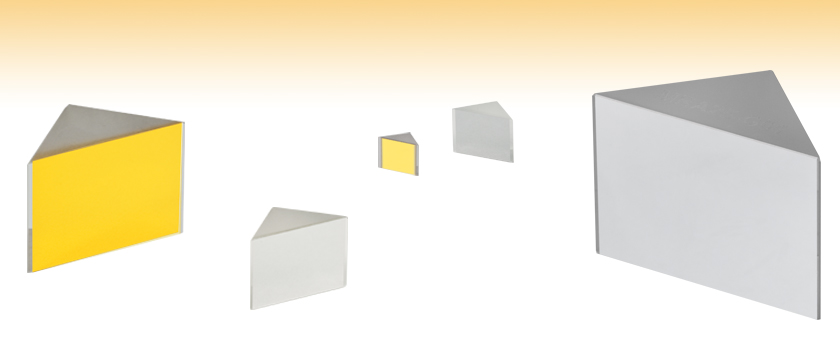
- UV-Enhanced Aluminum, Protected Aluminum, Protected Silver,
Protected Gold, and MIR-Enhanced Gold Coatings Available - Eight Leg Dimensions from 3.0 mm to 50.0 mm
MRA15-M01
(L = 15.0 mm)
MRA10-P01
(L = 10.0 mm)
MRA05-F01
(L = 5.0 mm)
MRA25-G01
(L = 25.0 mm)
MRA03-M02
(L = 3.0 mm)

Please Wait
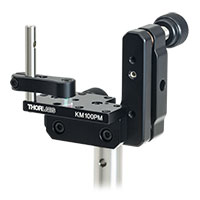
Click to Enlarge
The KM100PM(/M) can be used to mount our right angle prisms when used in combination with either a PM3(/M) or PM4(/M) clamping arm. Photographed above is an MRA03-E03 mirror.
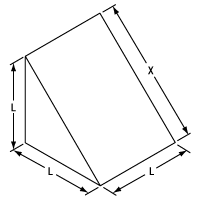
The size of these prisms is defined by the leg dimension, L, which is indicated in the product list below. See the Specs tab for full product dimensions.
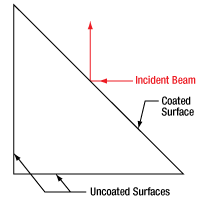
Schematic that demonstrates how to orient the right angle prism mirror with respect to the incident beam.
Features
- Reflective Coating on the Hypotenuse for Front Surface Reflections
- Five Metallic Coatings Available:
- UV-Enhanced Aluminum
- Protected Aluminum
- Protected Silver
- Protected Gold
- MIR-Enhanced Gold
- Eight Sizes Available with Leg Dimensions of:
- 3.0 mm
- 5.0 mm
- 10.0 mm
- 12.5 mm
- 15.0 mm
- 20.0 mm
- 25.0 mm
- 50.0 mm
- Designed for 0° to 45° Angles of Incidence (AOI)
- Fabricated from N-BK7 Glass Substrate
Thorlabs offers right-angle prism mirrors with the following reflective metallic coatings deposited on the prism's hypotenuse: UV enhanced aluminum, protected aluminum, protected silver, protected gold, or MIR-enhanced gold. The mirrors are designed to reflect light that is externally incident on the hypotenuse of the prism (see figure to the right), which has an optical-quality coated surface (see the Specs tab for details). These mirrors reduce alignment time and increase the rigidity of an optical system. Right angle prism mirrors featuring broadband dielectric coatings and Nd:YAG laser line coatings are also available.
As shown in the images above, there are tooling marks at the right and left edges of the coated hypotenuse. These tooling marks are part of the manufacturing process and do not infringe upon the clear aperture of the mirror (see Specs tab for details).
| Right Angle Prism Mirror Selection Guide |
|---|
| Hypotenuse Coated |
| Metallic Coatings (250 nm - 20 µm) |
| Dielectric Coatings (400 nm - 1100 nm) |
| Laser Line (532 nm and 1064 nm) |
| Leg Coated |
| Knife-Edge, Metallic and Dielectric Coatings (250 nm - 20 µm) |
| Dielectric Coatings (400 nm - 1100 nm) |
Please note that reflecting light off of the coated surface from inside the prism is not recommended because of the adhesion layers used in the coating process. The top and bottom surfaces of the prism have a fine ground glass finish.
The top surfaces of our 25.0 mm and 50.0 mm prisms are engraved with the Item # for quick identification. With the exception of the MIR-enhanced gold versions, the 25.0 mm prisms are also available mounted inside our 30 mm cage cubes.
| Item # | La | Xa | Prism Angular Tolerance | Reflectance (Click for Graph) |
|---|---|---|---|---|
| Protected Gold Coating: 800 nm - 20 µm | ||||
| MRA03-M01 | 3.0 mm | 4.2 mm | ±10 arcmin | Ravg > 96% (800 nm - 20 µm) |
| MRA05-M01 | 5.0 mm | 7.1 mm | ±3 arcmin | |
| MRA10-M01 | 10.0 mm | 14.1 mm | ||
| MRA12-M01 | 12.5 mm | 17.7 mm | ||
| MRA15-M01 | 15.0 mm | 21.2 mm | ||
| MRA20-M01 | 20.0 mm | 28.3 mm | ||
| MRA25-M01 | 25.0 mm | 35.4 mm | ||
| MRA50-M01 | 50.0 mm | 70.7 mm | ||
| Protected Gold Coating: 2 µm - 20 µm | ||||
| MRA03-M02 | 3.0 mm | 4.2 mm | ±10 arcmin | Ravg > 98% (2 µm - 20 µm) Rabs > 95% (2 µm - 20 µm) |
| MRA05-M02 | 5.0 mm | 7.1 mm | ±3 arcmin | |
| MRA10-M02 | 10.0 mm | 14.1 mm | ||
| MRA12-M02 | 12.5 mm | 17.7 mm | ||
| MRA15-M02 | 15.0 mm | 21.2 mm | ||
| MRA20-M02 | 20.0 mm | 28.3 mm | ||
| MRA25-M02 | 25.0 mm | 35.4 mm | ||
| MRA50-M02 | 50.0 mm | 70.7 mm | ||
| Item # | La | Xa | Prism Angular Tolerance | Reflectance (Click for Graph) |
|---|---|---|---|---|
| UV Enhanced Aluminum Coating: 250 nm - 450 nm | ||||
| MRA03-F01 | 3.0 mm | 4.2 mm | ±10 arcmin | Ravg > 90% (250 nm - 450 nm) |
| MRA05-F01 | 5.0 mm | 7.1 mm | ±3 arcmin | |
| MRA10-F01 | 10.0 mm | 14.1 mm | ||
| MRA12-F01 | 12.5 mm | 17.7 mm | ||
| MRA15-F01 | 15.0 mm | 21.2 mm | ||
| MRA20-F01 | 20.0 mm | 28.3 mm | ||
| MRA25-F01 | 25.0 mm | 35.4 mm | ||
| MRA50-F01 | 50.0 mm | 70.7 mm | ||
| Protected Aluminum Coating: 450 nm - 20 µm | ||||
| MRA03-G01 | 3.0 mm | 4.2 mm | ±10 arcmin | Ravg > 90% (450 nm - 2 µm) Ravg > 95% (2 µm - 20 µm) |
| MRA05-G01 | 5.0 mm | 7.1 mm | ±3 arcmin | |
| MRA10-G01 | 10.0 mm | 14.1 mm | ||
| MRA12-G01 | 12.5 mm | 17.7 mm | ||
| MRA15-G01 | 15.0 mm | 21.2 mm | ||
| MRA20-G01 | 20.0 mm | 28.3 mm | ||
| MRA25-G01 | 25.0 mm | 35.4 mm | ||
| MRA50-G01 | 50.0 mm | 70.7 mm | ||
| Protected Silver Coating: 450 nm - 20 µm | ||||
| MRA03-P01 | 3.0 mm | 4.2 mm | ±10 arcmin | Ravg > 97% (450 nm - 2 µm) Ravg > 95% (2 µm - 20 µm) |
| MRA05-P01 | 5.0 mm | 7.1 mm | ±3 arcmin | |
| MRA10-P01 | 10.0 mm | 14.1 mm | ||
| MRA12-P01 | 12.5 mm | 17.7 mm | ||
| MRA15-P01 | 15.0 mm | 21.2 mm | ||
| MRA20-P01 | 20.0 mm | 28.3 mm | ||
| MRA25-P01 | 25.0 mm | 35.4 mm | ||
| MRA50-P01 | 50.0 mm | 70.7 mm | ||
| Common Specifications | |
|---|---|
| Substrate Material | N-BK7a |
| Dimensional Tolerance | ±0.1 mm |
| Surface Flatness (Coated Surface) | λ/10 @ 633 nm (Peak to Valley) |
| Surface Quality (Coated Surface) | 40-20 Scratch-Dig |
| Clear Aperture | 70% of Face Length and Width |
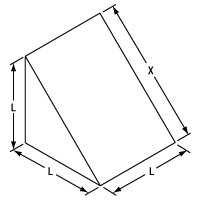
The size of these prisms is defined by
the leg dimension, L. See the table
to the right for dimensions.
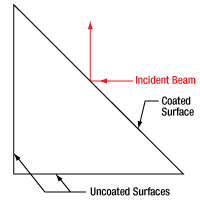
Schematic that demonstrates how to
orient the right angle prism mirror with
respect to the incident beam.
The shaded region in each graph denotes the spectral range over which the coating is highly reflective. Due to variations in each run, this recommended spectral range is narrower than the actual range over which the optic will be highly reflective. If you have any concerns about the interpretation of this data, please contact Tech Support.
UV-Enhanced Aluminum Coating (250 - 450 nm)
Protected Aluminum Coating (450 nm - 20 µm)
Protected Silver Coating (450 nm - 20 µm)
Protected Gold Coating (800 nm - 20 µm)
MIR-Enhanced Gold Coating (2 µm - 20 µm)
| Damage Threshold Specifications | ||
|---|---|---|
| Coating Designation (Item # Suffix) |
Damage Threshold | |
| -F01 | Pulse | 0.25 J/cm2 at 266 nm, 10 ns, 10 Hz, Ø0.150 mm 0.3 J/cm2 at 355 nm, 10 ns, 10 Hz, Ø0.381 mm |
| CWa | 300 W/cm at 1.064 µm, Ø0.044 mm 500 W/cm at 10.6 µm, Ø0.339 mm |
|
| -G01 | Pulse | 0.3 J/cm2 at 1064 nm, 10 ns, 10 Hz, Ø1.000 mm |
| CWa | 100 W/cm at 1.070 µm, Ø0.098 mm 350 W/cm at 10.6 µm, Ø0.339 mm |
|
| -P01 | Pulse | 0.225 J/cm2 (800 nm, 99 fs, 1 kHz, Ø0.167 mm) 3 J/cm2 (1064 nm, 10 ns, 10 Hz, Ø1.000 mm) |
| CWa | 500 W/cm (1.07 µm, Ø0.974 mm) 1500 W/cm (10.6 µm, Ø0.339 mm) |
|
| -M01 | Pulse | 2 J/cm2 (1.064 µm, 10 ns, 10 Hz, Ø1.000 mm) |
| CWa | 500 W/cm (1.070 µm, Ø0.089 mm) 750 W/cm (10.6 µm, Ø0.339 mm) |
|
| -M02 | Pulse | 0.1 J/cm2 at 1.064 µm, 10 ns, 10 Hz, Ø1.06 mm 3 J/cm2 at 10.6 µm, 100 ns, 1 Hz, Ø1.29 mm |
| CWa | 25 W/cm at 1.07 µm, Ø1.04 mm 450 W/cm at 10.6 µm, Ø1.18 mm |
|
Damage Threshold Data for Thorlabs' Right-Angle Prism Mirrors
The specifications to the right are measured data for Thorlabs' metallic right-angle prism mirrors. Damage threshold specifications are constant for a given coating type, regardless of the size of the mirror.
Laser Induced Damage Threshold Tutorial
The following is a general overview of how laser induced damage thresholds are measured and how the values may be utilized in determining the appropriateness of an optic for a given application. When choosing optics, it is important to understand the Laser Induced Damage Threshold (LIDT) of the optics being used. The LIDT for an optic greatly depends on the type of laser you are using. Continuous wave (CW) lasers typically cause damage from thermal effects (absorption either in the coating or in the substrate). Pulsed lasers, on the other hand, often strip electrons from the lattice structure of an optic before causing thermal damage. Note that the guideline presented here assumes room temperature operation and optics in new condition (i.e., within scratch-dig spec, surface free of contamination, etc.). Because dust or other particles on the surface of an optic can cause damage at lower thresholds, we recommend keeping surfaces clean and free of debris. For more information on cleaning optics, please see our Optics Cleaning tutorial.
Testing Method
Thorlabs' LIDT testing is done in compliance with ISO/DIS 11254 and ISO 21254 specifications.
First, a low-power/energy beam is directed to the optic under test. The optic is exposed in 10 locations to this laser beam for 30 seconds (CW) or for a number of pulses (pulse repetition frequency specified). After exposure, the optic is examined by a microscope (~100X magnification) for any visible damage. The number of locations that are damaged at a particular power/energy level is recorded. Next, the power/energy is either increased or decreased and the optic is exposed at 10 new locations. This process is repeated until damage is observed. The damage threshold is then assigned to be the highest power/energy that the optic can withstand without causing damage. A histogram such as that below represents the testing of one BB1-E02 mirror.

The photograph above is a protected aluminum-coated mirror after LIDT testing. In this particular test, it handled 0.43 J/cm2 (1064 nm, 10 ns pulse, 10 Hz, Ø1.000 mm) before damage.

| Example Test Data | |||
|---|---|---|---|
| Fluence | # of Tested Locations | Locations with Damage | Locations Without Damage |
| 1.50 J/cm2 | 10 | 0 | 10 |
| 1.75 J/cm2 | 10 | 0 | 10 |
| 2.00 J/cm2 | 10 | 0 | 10 |
| 2.25 J/cm2 | 10 | 1 | 9 |
| 3.00 J/cm2 | 10 | 1 | 9 |
| 5.00 J/cm2 | 10 | 9 | 1 |
According to the test, the damage threshold of the mirror was 2.00 J/cm2 (532 nm, 10 ns pulse, 10 Hz, Ø0.803 mm). Please keep in mind that these tests are performed on clean optics, as dirt and contamination can significantly lower the damage threshold of a component. While the test results are only representative of one coating run, Thorlabs specifies damage threshold values that account for coating variances.
Continuous Wave and Long-Pulse Lasers
When an optic is damaged by a continuous wave (CW) laser, it is usually due to the melting of the surface as a result of absorbing the laser's energy or damage to the optical coating (antireflection) [1]. Pulsed lasers with pulse lengths longer than 1 µs can be treated as CW lasers for LIDT discussions.
When pulse lengths are between 1 ns and 1 µs, laser-induced damage can occur either because of absorption or a dielectric breakdown (therefore, a user must check both CW and pulsed LIDT). Absorption is either due to an intrinsic property of the optic or due to surface irregularities; thus LIDT values are only valid for optics meeting or exceeding the surface quality specifications given by a manufacturer. While many optics can handle high power CW lasers, cemented (e.g., achromatic doublets) or highly absorptive (e.g., ND filters) optics tend to have lower CW damage thresholds. These lower thresholds are due to absorption or scattering in the cement or metal coating.

LIDT in linear power density vs. pulse length and spot size. For long pulses to CW, linear power density becomes a constant with spot size. This graph was obtained from [1].

Pulsed lasers with high pulse repetition frequencies (PRF) may behave similarly to CW beams. Unfortunately, this is highly dependent on factors such as absorption and thermal diffusivity, so there is no reliable method for determining when a high PRF laser will damage an optic due to thermal effects. For beams with a high PRF both the average and peak powers must be compared to the equivalent CW power. Additionally, for highly transparent materials, there is little to no drop in the LIDT with increasing PRF.
In order to use the specified CW damage threshold of an optic, it is necessary to know the following:
- Wavelength of your laser
- Beam diameter of your beam (1/e2)
- Approximate intensity profile of your beam (e.g., Gaussian)
- Linear power density of your beam (total power divided by 1/e2 beam diameter)
Thorlabs expresses LIDT for CW lasers as a linear power density measured in W/cm. In this regime, the LIDT given as a linear power density can be applied to any beam diameter; one does not need to compute an adjusted LIDT to adjust for changes in spot size, as demonstrated by the graph to the right. Average linear power density can be calculated using the equation below.

The calculation above assumes a uniform beam intensity profile. You must now consider hotspots in the beam or other non-uniform intensity profiles and roughly calculate a maximum power density. For reference, a Gaussian beam typically has a maximum power density that is twice that of the uniform beam (see lower right).
Now compare the maximum power density to that which is specified as the LIDT for the optic. If the optic was tested at a wavelength other than your operating wavelength, the damage threshold must be scaled appropriately. A good rule of thumb is that the damage threshold has a linear relationship with wavelength such that as you move to shorter wavelengths, the damage threshold decreases (i.e., a LIDT of 10 W/cm at 1310 nm scales to 5 W/cm at 655 nm):

While this rule of thumb provides a general trend, it is not a quantitative analysis of LIDT vs wavelength. In CW applications, for instance, damage scales more strongly with absorption in the coating and substrate, which does not necessarily scale well with wavelength. While the above procedure provides a good rule of thumb for LIDT values, please contact Tech Support if your wavelength is different from the specified LIDT wavelength. If your power density is less than the adjusted LIDT of the optic, then the optic should work for your application.
Please note that we have a buffer built in between the specified damage thresholds online and the tests which we have done, which accommodates variation between batches. Upon request, we can provide individual test information and a testing certificate. The damage analysis will be carried out on a similar optic (customer's optic will not be damaged). Testing may result in additional costs or lead times. Contact Tech Support for more information.
Pulsed Lasers
As previously stated, pulsed lasers typically induce a different type of damage to the optic than CW lasers. Pulsed lasers often do not heat the optic enough to damage it; instead, pulsed lasers produce strong electric fields capable of inducing dielectric breakdown in the material. Unfortunately, it can be very difficult to compare the LIDT specification of an optic to your laser. There are multiple regimes in which a pulsed laser can damage an optic and this is based on the laser's pulse length. The highlighted columns in the table below outline the relevant pulse lengths for our specified LIDT values.
Pulses shorter than 10-9 s cannot be compared to our specified LIDT values with much reliability. In this ultra-short-pulse regime various mechanics, such as multiphoton-avalanche ionization, take over as the predominate damage mechanism [2]. In contrast, pulses between 10-7 s and 10-4 s may cause damage to an optic either because of dielectric breakdown or thermal effects. This means that both CW and pulsed damage thresholds must be compared to the laser beam to determine whether the optic is suitable for your application.
| Pulse Duration | t < 10-9 s | 10-9 < t < 10-7 s | 10-7 < t < 10-4 s | t > 10-4 s |
|---|---|---|---|---|
| Damage Mechanism | Avalanche Ionization | Dielectric Breakdown | Dielectric Breakdown or Thermal | Thermal |
| Relevant Damage Specification | No Comparison (See Above) | Pulsed | Pulsed and CW | CW |
When comparing an LIDT specified for a pulsed laser to your laser, it is essential to know the following:

LIDT in energy density vs. pulse length and spot size. For short pulses, energy density becomes a constant with spot size. This graph was obtained from [1].
- Wavelength of your laser
- Energy density of your beam (total energy divided by 1/e2 area)
- Pulse length of your laser
- Pulse repetition frequency (prf) of your laser
- Beam diameter of your laser (1/e2 )
- Approximate intensity profile of your beam (e.g., Gaussian)
The energy density of your beam should be calculated in terms of J/cm2. The graph to the right shows why expressing the LIDT as an energy density provides the best metric for short pulse sources. In this regime, the LIDT given as an energy density can be applied to any beam diameter; one does not need to compute an adjusted LIDT to adjust for changes in spot size. This calculation assumes a uniform beam intensity profile. You must now adjust this energy density to account for hotspots or other nonuniform intensity profiles and roughly calculate a maximum energy density. For reference a Gaussian beam typically has a maximum energy density that is twice that of the 1/e2 beam.
Now compare the maximum energy density to that which is specified as the LIDT for the optic. If the optic was tested at a wavelength other than your operating wavelength, the damage threshold must be scaled appropriately [3]. A good rule of thumb is that the damage threshold has an inverse square root relationship with wavelength such that as you move to shorter wavelengths, the damage threshold decreases (i.e., a LIDT of 1 J/cm2 at 1064 nm scales to 0.7 J/cm2 at 532 nm):

You now have a wavelength-adjusted energy density, which you will use in the following step.
Beam diameter is also important to know when comparing damage thresholds. While the LIDT, when expressed in units of J/cm², scales independently of spot size; large beam sizes are more likely to illuminate a larger number of defects which can lead to greater variances in the LIDT [4]. For data presented here, a <1 mm beam size was used to measure the LIDT. For beams sizes greater than 5 mm, the LIDT (J/cm2) will not scale independently of beam diameter due to the larger size beam exposing more defects.
The pulse length must now be compensated for. The longer the pulse duration, the more energy the optic can handle. For pulse widths between 1 - 100 ns, an approximation is as follows:

Use this formula to calculate the Adjusted LIDT for an optic based on your pulse length. If your maximum energy density is less than this adjusted LIDT maximum energy density, then the optic should be suitable for your application. Keep in mind that this calculation is only used for pulses between 10-9 s and 10-7 s. For pulses between 10-7 s and 10-4 s, the CW LIDT must also be checked before deeming the optic appropriate for your application.
Please note that we have a buffer built in between the specified damage thresholds online and the tests which we have done, which accommodates variation between batches. Upon request, we can provide individual test information and a testing certificate. Contact Tech Support for more information.
[1] R. M. Wood, Optics and Laser Tech. 29, 517 (1998).
[2] Roger M. Wood, Laser-Induced Damage of Optical Materials (Institute of Physics Publishing, Philadelphia, PA, 2003).
[3] C. W. Carr et al., Phys. Rev. Lett. 91, 127402 (2003).
[4] N. Bloembergen, Appl. Opt. 12, 661 (1973).
In order to illustrate the process of determining whether a given laser system will damage an optic, a number of example calculations of laser induced damage threshold are given below. For assistance with performing similar calculations, we provide a spreadsheet calculator that can be downloaded by clicking the button to the right. To use the calculator, enter the specified LIDT value of the optic under consideration and the relevant parameters of your laser system in the green boxes. The spreadsheet will then calculate a linear power density for CW and pulsed systems, as well as an energy density value for pulsed systems. These values are used to calculate adjusted, scaled LIDT values for the optics based on accepted scaling laws. This calculator assumes a Gaussian beam profile, so a correction factor must be introduced for other beam shapes (uniform, etc.). The LIDT scaling laws are determined from empirical relationships; their accuracy is not guaranteed. Remember that absorption by optics or coatings can significantly reduce LIDT in some spectral regions. These LIDT values are not valid for ultrashort pulses less than one nanosecond in duration.

A Gaussian beam profile has about twice the maximum intensity of a uniform beam profile.
CW Laser Example
Suppose that a CW laser system at 1319 nm produces a 0.5 W Gaussian beam that has a 1/e2 diameter of 10 mm. A naive calculation of the average linear power density of this beam would yield a value of 0.5 W/cm, given by the total power divided by the beam diameter:

However, the maximum power density of a Gaussian beam is about twice the maximum power density of a uniform beam, as shown in the graph to the right. Therefore, a more accurate determination of the maximum linear power density of the system is 1 W/cm.
An AC127-030-C achromatic doublet lens has a specified CW LIDT of 350 W/cm, as tested at 1550 nm. CW damage threshold values typically scale directly with the wavelength of the laser source, so this yields an adjusted LIDT value:

The adjusted LIDT value of 350 W/cm x (1319 nm / 1550 nm) = 298 W/cm is significantly higher than the calculated maximum linear power density of the laser system, so it would be safe to use this doublet lens for this application.
Pulsed Nanosecond Laser Example: Scaling for Different Pulse Durations
Suppose that a pulsed Nd:YAG laser system is frequency tripled to produce a 10 Hz output, consisting of 2 ns output pulses at 355 nm, each with 1 J of energy, in a Gaussian beam with a 1.9 cm beam diameter (1/e2). The average energy density of each pulse is found by dividing the pulse energy by the beam area:

As described above, the maximum energy density of a Gaussian beam is about twice the average energy density. So, the maximum energy density of this beam is ~0.7 J/cm2.
The energy density of the beam can be compared to the LIDT values of 1 J/cm2 and 3.5 J/cm2 for a BB1-E01 broadband dielectric mirror and an NB1-K08 Nd:YAG laser line mirror, respectively. Both of these LIDT values, while measured at 355 nm, were determined with a 10 ns pulsed laser at 10 Hz. Therefore, an adjustment must be applied for the shorter pulse duration of the system under consideration. As described on the previous tab, LIDT values in the nanosecond pulse regime scale with the square root of the laser pulse duration:

This adjustment factor results in LIDT values of 0.45 J/cm2 for the BB1-E01 broadband mirror and 1.6 J/cm2 for the Nd:YAG laser line mirror, which are to be compared with the 0.7 J/cm2 maximum energy density of the beam. While the broadband mirror would likely be damaged by the laser, the more specialized laser line mirror is appropriate for use with this system.
Pulsed Nanosecond Laser Example: Scaling for Different Wavelengths
Suppose that a pulsed laser system emits 10 ns pulses at 2.5 Hz, each with 100 mJ of energy at 1064 nm in a 16 mm diameter beam (1/e2) that must be attenuated with a neutral density filter. For a Gaussian output, these specifications result in a maximum energy density of 0.1 J/cm2. The damage threshold of an NDUV10A Ø25 mm, OD 1.0, reflective neutral density filter is 0.05 J/cm2 for 10 ns pulses at 355 nm, while the damage threshold of the similar NE10A absorptive filter is 10 J/cm2 for 10 ns pulses at 532 nm. As described on the previous tab, the LIDT value of an optic scales with the square root of the wavelength in the nanosecond pulse regime:

This scaling gives adjusted LIDT values of 0.08 J/cm2 for the reflective filter and 14 J/cm2 for the absorptive filter. In this case, the absorptive filter is the best choice in order to avoid optical damage.
Pulsed Microsecond Laser Example
Consider a laser system that produces 1 µs pulses, each containing 150 µJ of energy at a repetition rate of 50 kHz, resulting in a relatively high duty cycle of 5%. This system falls somewhere between the regimes of CW and pulsed laser induced damage, and could potentially damage an optic by mechanisms associated with either regime. As a result, both CW and pulsed LIDT values must be compared to the properties of the laser system to ensure safe operation.
If this relatively long-pulse laser emits a Gaussian 12.7 mm diameter beam (1/e2) at 980 nm, then the resulting output has a linear power density of 5.9 W/cm and an energy density of 1.2 x 10-4 J/cm2 per pulse. This can be compared to the LIDT values for a WPQ10E-980 polymer zero-order quarter-wave plate, which are 5 W/cm for CW radiation at 810 nm and 5 J/cm2 for a 10 ns pulse at 810 nm. As before, the CW LIDT of the optic scales linearly with the laser wavelength, resulting in an adjusted CW value of 6 W/cm at 980 nm. On the other hand, the pulsed LIDT scales with the square root of the laser wavelength and the square root of the pulse duration, resulting in an adjusted value of 55 J/cm2 for a 1 µs pulse at 980 nm. The pulsed LIDT of the optic is significantly greater than the energy density of the laser pulse, so individual pulses will not damage the wave plate. However, the large average linear power density of the laser system may cause thermal damage to the optic, much like a high-power CW beam.
| Posted Comments: | |
PATTABHI DYTA
(posted 2024-07-19 23:31:15.03) Hi, is there an angle of acceptance/numerical aperture specification on these? The use case would be intraoral imaging where an angular field of view of about 90degrees is needed. cdolbashian
(posted 2024-07-29 11:24:06.0) Thank you for reaching out to us with this inquiry. These mirrors are planar mirrors such that the FOV is simply following normal laws of reflection. I have reached out to you directly to address your concerns and learn a bit more about your application. Fabian Cadiz
(posted 2024-02-22 08:24:53.997) Hi, I recently bought a MRA25-P01 (Silver protected prism) and i found that it greatly preserves the incident light's polarization after reflection (circular and linear at 45 degrees, for example) over the range 400nm-1000 nm. I am a bit surprised, i don't recall silver protected mirrors to preserve the polarization that much, is there a crucial difference between these prisms and the round mirrors? Do you expect the polarization to be maintained? Thanks! cdolbashian
(posted 2024-03-01 03:46:33.0) Thank you for reaching out to us with this inquiry. Following a discussion and some tests on your end, you found that there was no noticeable difference between these two mirror shapes, considering that both the substrate and coating are identical. Generally, uncoated metallic mirrors have the best polarization preservation, followed by coated metallic mirrors, and finally dielectric mirrors. 传韡 艾
(posted 2023-11-10 11:16:35.137) 请问在不破坏镜面的情况下,是否存在合理的方法去除二氧化硅保护层呢?例如使用光纤抛光纸打磨是否可行 cdolbashian
(posted 2023-11-17 10:23:15.0) Thank you for reaching out to us with this inquiry. I have contacted you directly regarding your need to remove the protective coating from these mirrors. 传韡 艾
(posted 2023-11-08 14:34:54.733) 镀银膜的直角反射棱镜,在不破坏镜面的基础上可以去除部分银膜吗?可以的话用什么方法可以去除呢?谢谢 cdolbashian
(posted 2023-11-16 02:50:12.0) Thank you for reaching out to us with this inquiry. I have contacted you directly regarding your need to strip the mirror coating from your mirror. Angel Mendez
(posted 2023-08-25 09:52:20.047) Greetings! We are a team from the spectroscopy laboratory at the Escuela Politécnica Nacional and we are very interested in the right angle prisms offered by Thorlabs for surface plasmon resonance applications. However, we need specific information about the thickness of the gold coating on these prisms. cdolbashian
(posted 2023-08-30 01:06:21.0) Thank you for reaching out to us with this inquiry. Unfortunately, we cannot provide such information regarding the coating, as it is considered proprietary. Chen Avinadav
(posted 2021-01-06 01:43:05.107) Does the SiO2 overcoat provide protection against deposition of alkali atoms (Rb, Cs, ...) in UHV applications? YLohia
(posted 2021-01-19 03:48:19.0) Hello, unfortunately, we do not have information on whether the overcoat will prevent deposition of other materials. We would expect deposition to be governed by energy of the atoms in question, but we don't have any data on this and thus cannot provide more in-depth comments. Xavier Attendu
(posted 2020-08-28 15:12:36.41) I see in the comments, that others have requested smaller prism sizes. We are looking for a 1 mm right-angle prism mirror. Please let me know if this is still possible. Thanks in advance. Best regards, Xavier YLohia
(posted 2020-08-31 10:30:50.0) Hello Xavier, custom optics can be requested by emailing your local Thorlabs Tech Support team (in your case, europe@thorlabs.com). We will reach out to you directly to discuss the possibility of offering this. user
(posted 2019-11-07 21:03:36.903) Hi, would it be possible to offer smaller prisms as well? We would have uses for 0.2, 0.5 and 1 mm prisms. nbayconich
(posted 2019-11-07 04:45:57.0) Thank you for contacting Thorlabs. We have quoted prisms smaller than 3mm in the past. I will reach out to you directly to discuss our custom capabilities. lebouquj
(posted 2018-09-24 12:00:11.703) Is the λ/10 @ 633 nm for surface flatness defined as max-to-min or rms ? And is it in surface or reflected beam (twice surface) ?
Thanks, Jean-Baptiste YLohia
(posted 2018-09-25 09:29:54.0) Hello Jean-Baptiste, when specifying the surface flatness, we use peak-to-valley. Peak-to-valley for flatness speaks to the extremes of the measurements, and comes from using test plates for spot checking. In general, the peak-to-valley tends to be 3-5x greater than the rms, but this can depend case-to-case. For this spec, we are referring to the actual coated surface flatness, not the reflected wavefront error. lebouquj
(posted 2018-06-07 15:41:12.367) Hi, we would like to use the reflective surface very close to one of the 45edges. Ideally <100um. Does the coating extend that close to the edge ? The so-called "Knife-Edge prism" are not usable in our case because the coating is on the 'wrong' surfaces. Thanks, Jean-Baptiste YLohia
(posted 2018-06-13 03:48:30.0) Hello, Jean-Baptiste, thank you for contacting Thorlabs. No, this coating does not extend all the way to the edge. The clear aperture is specified to be 70% of the length and the width of the mirror. The coating towards the edges is not expected to perform well. zuomin.zhao
(posted 2017-08-10 10:30:36.757) Hi, We ordered a UV fused silica right-angle prism (15 mm)from Thorlabs. Could you please directly vacuum evaporate a aluminum film (~200 micron thickness)on the Hypotenuse of the prism without any glue? The aluminun film should be a mirror without pores. Please tell me how the cost if you can do it for us, thank you r very much. tfrisch
(posted 2017-08-16 05:37:12.0) Hello, thank you for contacting Thorlabs. Our metallic coatings are not glued, they are evaporated coatings. I will reach out to you directly about your application, but MRA15-G01 seems similar to what you are describing. nicolas
(posted 2017-02-14 17:40:09.093) What is the thickness of
- the silver mirror?
- the SiO2 protective layer?
Thanks. tfrisch
(posted 2017-02-16 02:54:48.0) Hello, thank you for contacting Thorlabs. Unfortunately, the thicknesses of our coating layers are proprietary. I will reach out to you directly about your application. th6187
(posted 2014-05-21 10:33:29.11) Dear Thorlabs team,
you sell uncoated prism down to a size of L = 3 mm (e.g. PS605), but the smallest coated ones have L = 5 mm (e.g. MRA05-P01).
Is it possible to get a 3 mm right-angle prism mirror (preferably with protected silver coating)? If yes, what would the costs and lead time be?
And could you tell me the approximate damage threshold of a protected silver coating for a 532 nm CW laser?
Thank you! SR besembeson
(posted 2014-05-21 05:00:28.0) A response from Bweh Esembeson at Thorlabs USA: Thanks for contacting Thorlabs. We can provide this to you as a custom item. I will follow-up with you by email for a quotation.
Regarding the damage threshold for the protected silver, this can be found at the following link under the “Specs” tab, http://www.thorlabs.com/newgrouppage9.cfm?objectgroup_id=905&pn=MRA05-P01#3360. mt_Reilly
(posted 2013-09-22 05:04:40.967) I have a question about silver vs. Gold coatings for front surface reflectors. Silver oxidizes far more readily that the somewhat chemically inert gold. Silver is a slightly better reflector though. Do you coat the silver to protect it from oxidation? Also, how well does the gold adhere to the substrate? I understand that there are concerns on this front too.
Thanks for your time.
Mike jlow
(posted 2013-09-24 12:51:00.0) Response from Jeremy at Thorlabs: There's a SiO2 protective layer on the silver mirror. Both the gold and silver mirrors have adhesion layer to help it adhere to the substrates. bdada
(posted 2011-11-07 17:31:00.0) Response from Buki at Thorlabs:
Thank you for your interest in our prism mirrors. We can provide custom sizes. We have contacted you for more information so we can generate a quote. Martin. Vogel
(posted 2011-11-04 21:28:29.0) Would it be possible to get these prisms 30 mm in height? bdada
(posted 2011-09-29 12:52:00.0) Response from Buki at Thorlabs:
The damage threshold for the dielectric coating is 2kW/cm^2 at 532nm for CW light. The damage threshold for the UV enhanced aluminum coating is 50W/cm^2 at 1064 nm and 2000kW/cm2 for the gold coating. Although the damage threshold for the coatings is not always tested at 532nm, you can use the information above as a point of reference.
Please contact TechSupport@thorlabs.com if you have further questions. cristina.martinez-g
(posted 2011-09-27 12:46:30.0) Hello,
I would need to know the damage threshold for your right angle prism mirrors for a continuous wave at 532nnm.
Thank you very much
cristina jjurado
(posted 2011-07-22 17:20:00.0) Response from Javier at Thorlabs to max.stumpf: Thank you for submitting your request. We can certainly offer our right angle prisms coated with the E04 (1280-1600nm) broadband dielectric coating. The price will depend on the quantity required. I will contact you directly to start the quotation process. max.stumpf
(posted 2011-07-22 06:29:35.0) Hi, I just wonder, whether Thorlabs could also offer these prisms with an EO4 coating (HR at 1550)? Can you comment on price and lead time for such a customization? jjurado
(posted 2011-06-27 16:10:00.0) Response from Javier at Thorlabs to dvsunm: Thank you very much for contacting us. I will send you theoretical reflectivity plots for our protected metal coatings shortly. Regarding the thickness of the coating, the typical value for this specification is 0.1 to 0.13 um. dvsunm
(posted 2011-06-24 18:59:04.0) Hi, Im interested in response of these mirrors beyond 20 um. Do you by any chance have reflectivity measurement beyond 20um and can you please specify what is the thickness of a metal coating?
Thank you Customer Email: dvsunm@gmail.com This customer would like to be contacted. Tyler
(posted 2008-06-04 11:06:00.0) A response from Tyler at Thorlabs to Julia: Thank you for pointing out the typo mistakes in the part numbers listed in the "Specs" tab. They have been corrected. j.staehler1
(posted 2008-06-04 10:21:13.0) Hi,
I just wanted to let you know that the product numbers for the metal coated prism mirrors of the overview page and the "specs" page do not coincide.
Cheers
Julia |

- Eight Sizes Available with Leg Dimensions of 3.0 mm, 5.0 mm, 10.0 mm, 12.5 mm, 15.0 mm, 20.0 mm, 25.0 mm, or 50.0 mm (See Above Diagrams for Details)
- Average Reflectance: >90% (250 - 450 nm)
These UV-enhanced-aluminum-coated right-angle prism mirrors are ideal for use with light from 250 to 450 nm at normal to 45° angles of incidence. The coating provides high reflectance for both s- and p-polarized light. For more information on the typical performance of these mirrors, please see the Graphs tab. For detailed specifications on each prism mirror, please see the Specs tab.

- Eight Sizes Available with Leg Dimensions of 3.0 mm, 5.0 mm, 10.0 mm, 12.5 mm, 15.0 mm, 20.0 mm, 25.0 mm, or 50.0 mm (See Above Diagrams for Details)
- Average Reflectance: >90% (450 nm - 2 µm), >95% (2 - 20 µm)
These protected-aluminum-coated right-angle prism mirrors are ideal for use with light from 450 nm to 20 µm at normal to 45° angles of incidence. The coating provides high reflectance for both s- and p-polarized light. The aluminum coating features a protective overcoat of SiO2 and has a smaller chance of tarnishing than protected silver in a high humidity environment. For more information on the typical performance of these mirrors, please see the Graphs tab. For detailed specifications on each prism mirror, please see the Specs tab.

- Eight Sizes Available with Leg Dimensions of 3.0 mm, 5.0 mm, 10.0 mm, 12.5 mm, 15.0 mm, 20.0 mm, 25.0 mm, or 50.0 mm (See Above Diagrams for Details)
- Average Reflectance: >97% (450 nm - 2 µm), >95% (2 - 20 µm)
These protected-silver-coated right-angle prism mirrors are ideal for use with light from 450 nm to 20 µm at normal to 45° angles of incidence. The coating provides high reflectance for both s- and p-polarized light. For more information on the typical performance of these mirrors, please see the Graphs tab. For detailed specifications on each prism mirror, please see the Specs tab.
The silver coating features a protective overcoat of SiO2. Though the overcoat helps to protect silver from tarnishing, high humidity environments should be avoided. Due to their high reflectivity over the 450 nm - 20 µm range, these mirrors are well suited for use with femtosecond pulsed lasers.
Care and Handling
Silver coated mirrors require additional care due to their susceptibility to damage from environmental conditions and improper handling. Fingerprints, contact with abrasive surfaces, and environments with high humidity or temperature will diminish the effectiveness of the protective overcoat leaving the silver coating susceptible to oxidation and degradation. When working with silver mirrors, follow standard practices for handling optics. Latex gloves or similar protective coverings are recommended to prevent oil and other residues on the user’s fingers from reaching the optical surface. Even with such precautions, care should be taken not to touch the mirrored face or edges. Silver mirrors should be used and stored in areas at room temperature with minimal humidity. For information on how to clean mirrors and other optics, visit our Optic Cleaning Tutorial.

- Eight Sizes Available with Leg Dimensions of 3.0 mm, 5.0 mm, 10.0 mm, 12.5 mm, 15.0 mm, 20.0 mm, 25.0 mm, or 50.0 mm (See Above Diagrams for Details)
- Average Reflectance: >96% (800 nm - 20 µm)
These protected-gold-coated right angle prism mirrors are ideal for use with light from 800 nm to 20 µm at normal to 45° angles of incidence. The coating provides high reflectance for both s- and p-polarized light. The gold coating features a protective overcoat of SiO2. For more information on the typical performance of these mirrors, please see the Graphs tab. For detailed specifications on each prism mirror, please see the Specs tab.

- Eight Sizes Available with Leg Dimensions of 3.0 mm, 5.0 mm, 10.0 mm, 12.5 mm, 15.0 mm, 20.0 mm, 25.0 mm, or 50.0 mm (See Above Diagrams for Details)
- Average Reflectance: >98% (2 µm - 20 µm)
- Absolute Reflectance: >95% (2 µm - 20 µm)
These MIR-enhanced-gold-coated right-angle prism mirrors are ideal for use with light from 2 to 20 µm at normal to 45° angles of incidence. The coating provides high reflectance for both s- and p-polarized light. The gold coating features a protective overcoat per MIL-C-48497A. The overcoat on these mirrors allows them to perform better than our unprotected gold mirrors in the mid-infrared (MIR), while offering resistance to physical damages. For more information on the typical performance of these mirrors, please see the Graphs tab. For detailed specifications on each prism mirror, please see the Specs tab.
 Products Home
Products Home








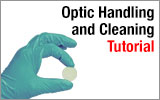
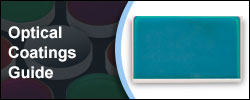
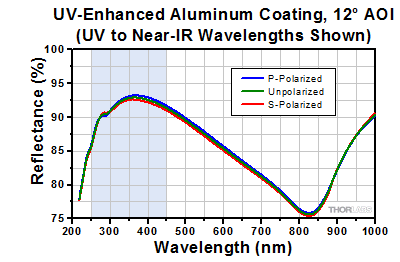
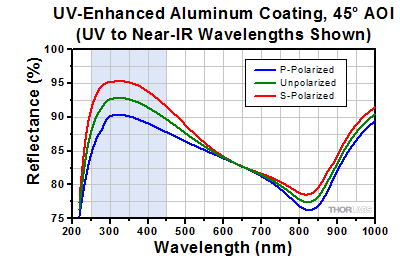
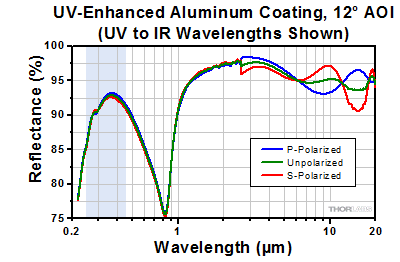
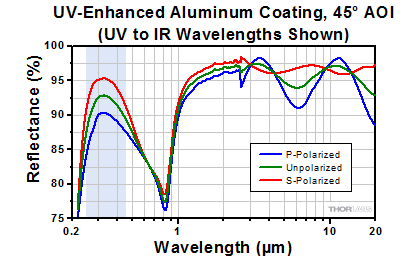
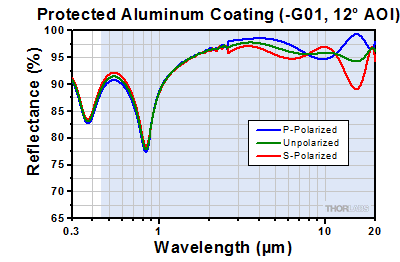
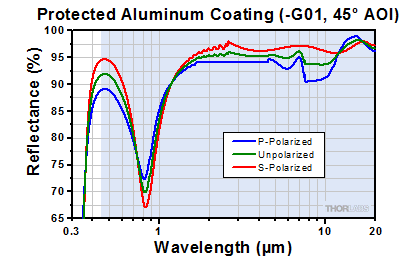
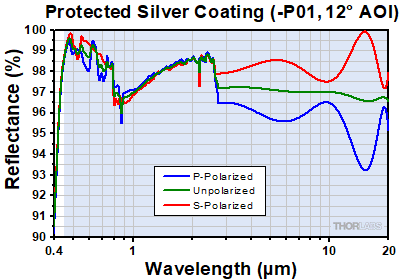
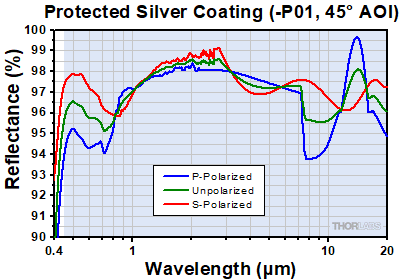
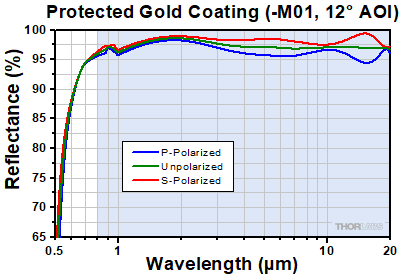
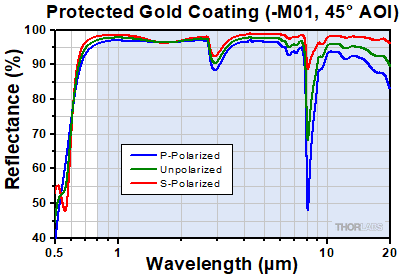
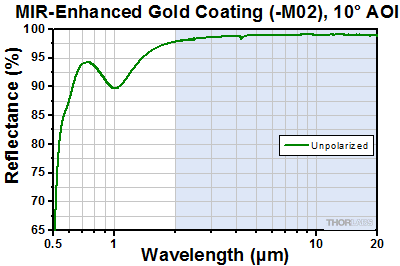
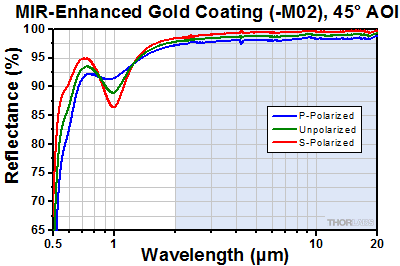

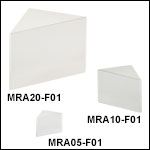
 Zoom
Zoom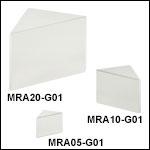
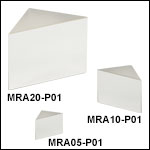
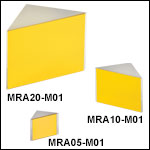
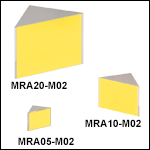
 Prism Mirrors, Metallic Coating
Prism Mirrors, Metallic Coating